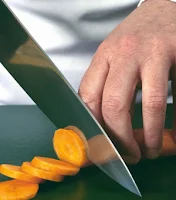Welcome to the second installment in a series of posts geared toward the 'at home cook.' It is my belief that anyone can cook gourmet at home and this series is designed to give you, the at home cook, foodie, culinary enthusiast, the techniques and methods used by every professional chef, in order to allow you to create wonderful restaurant style gourmet meals at home. Our first, Mise en Place, was all about proper kitchen set up when attempting a recipe or preparing a meal for your family.
With today's installment, Knife Skills, we will examine the techniques and proper methods of using a chef's knife. The chef’s knife is the ideal knife for chopping vegetables, herbs, fruits, cutting boneless meats, slicing, dicing and general cutting tasks. A chef's knife generally has a blade eight inches (20 cm) in length and 1 ½ inches (4 cm) in width, although individual models range from 6 to 14 inches (15 cm to 36 cm) in length. Blade shapes are either French or German; the French style has an edge that is straighter with the end curving up to the tip; German-style knives are more deeply and continuously curved along the whole cutting edge.
Sharpening Your Knives
It's important to keep knives sharp to stay safe when cooking,as dull knives are a safety hazard and can be very dangerous.The more blunt a knife's edge is, the more pressure it takes to cut something, the more likely you are to slip and cut your finger instead. Sharpened knives reduce the time it takes to prepare your meals as well. To sharpen a knife, use a sharpening stone, also known as a whetstone, or a sharpening stick. If you don't feel comfortable sharpening your knives yourself, most knife manufacturing companies allow you send your knives in for professional sharpening. You could also try your favorite cooking supply store, as most offer sharpening services.
How To Properly Hold & Use Your Knife


For more precise control, adopt a grip on the blade itself, with the thumb and the index finger grasping the blade just to the front of the finger guard and the middle finger placed just opposite, on the handle side of the finger guard below the bolster.
How To Properly Hold & Use Your Knife


For more precise control, adopt a grip on the blade itself, with the thumb and the index finger grasping the blade just to the front of the finger guard and the middle finger placed just opposite, on the handle side of the finger guard below the bolster.
When slicing or chopping, keep your fingertips curled inward. Use your fingernails in what is called a "claw grip," to help grip the food. The knife blade should rest against the foremost knuckle, helping keep the blade perpendicular to the board.
Types Of Knife Cuts
Large dice: ¾ inch × ¾ inch × ¾ inch.
Medium dice: ½ inch × ½ inch × ½ inch.
Small dice: ¼ inch × ¼ inch × ¼ inch
Batonnet: ½ inch × ½ inch × 2½-3 inches.
Aluumette: (al-yoo-MET) ¼ inch × ¼ inch × 2½ inches.
Julienne: (joo-lee-ENN) 1/8 inch × 1/8 inch × 2½ inches.
Brunoise: (BROON-wahz) 1/8 inch × 1/8 inch × 1/8 inch.
Fine Julienne: 1/16 inch × 1/16 inch × 2 inches.
Fine Brunoise: 1/16 inch × 1/16 inch × 1/16 inch.
Paysanne: ½ inch x ½ inch x 1/8 inch
Tourne (turned) 7 Sides: ¾ inch (width) x 2 inches (length)
For those who would like to take this post a step further, below is a list of available classes in New York, Chicago and LA, allowing you to get hands on experiences and instruction:
For my New York City readers:, Chef Norman Weinstein offers an excellent knife skills class at the Institute for Culinary Education on 23rd St. in NYC.
For my Chicago readers: The Chopping Block, located on Lincoln Ave offers regular classes for $40 per person.
For my LA readers: Chef Eric Jaques Crowely, of The Culinary Classroom offers regular classes on a variety of subjects, all of which includes knife skills instruction.
I hope this post has been educational and informative and helps you get more proficient in the kitchen. The number one (1) answer I have received when interviewing chefs about their most important or favorite kitchen tool is unequivocally; their knives. If you are serious about cooking and becoming more adept in the kitchen, learning how to use your knives with proper techniques and practice can make the cooking experience much more enjoyable. The time spent getting to know your knives will allow you to not only be more safe, but I'll bet you, your friends and your family will appreciate and enjoy your new culinary acumen and the delicious gourmet dishes coming out of your kitchen.
As always, Bon Appetit!
Lou
Photo sources: www.cheftalk.com http://www.myrecipes.com/ http://www.ciaprochef.com/




No comments:
Post a Comment